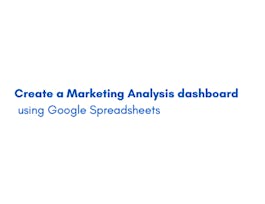How can you put data to work for you? Specifically, how can numbers in a spreadsheet tell us about present and past business activities, and how can we use them to forecast the future? The answer is in building quantitative models, and this course is designed to help you understand the fundamentals of this critical, foundational, business skill. Through a series of short lectures, demonstrations, and assignments, you’ll learn the key ideas and process of quantitative modeling so that you can begin to create your own models for your own business or enterprise. By the end of this course, you will have seen a variety of practical commonly used quantitative models as well as the building blocks that will allow you to start structuring your own models. These building blocks will be put to use in the other courses in this Specialization.



Fundamentals of Quantitative Modeling
Dieser Kurs ist Teil mehrerer Programme.

Dozent: Richard Waterman
236.655 bereits angemeldet
Bei  enthalten
enthalten
(8,969 Bewertungen)
Kompetenzen, die Sie erwerben
- Kategorie: Modeling
- Kategorie: Linear Regression
- Kategorie: Probabilistic Models
- Kategorie: Regression Analysis
Wichtige Details

Zu Ihrem LinkedIn-Profil hinzufügen
4 Aufgaben
Erfahren Sie, wie Mitarbeiter führender Unternehmen gefragte Kompetenzen erwerben.

Erweitern Sie Ihre Fachkenntnisse
- Lernen Sie neue Konzepte von Branchenexperten
- Gewinnen Sie ein Grundverständnis bestimmter Themen oder Tools
- Erwerben Sie berufsrelevante Kompetenzen durch praktische Projekte
- Erwerben Sie ein Berufszertifikat zur Vorlage


Erwerben Sie ein Karrierezertifikat.
Fügen Sie diese Qualifikation zur Ihrem LinkedIn-Profil oder Ihrem Lebenslauf hinzu.
Teilen Sie es in den sozialen Medien und in Ihrer Leistungsbeurteilung.

In diesem Kurs gibt es 4 Module
In this module, you will learn how to define a model, and how models are commonly used. You’ll examine the central steps in the modeling process, the four key mathematical functions used in models, and the essential vocabulary used to describe models. By the end of this module, you’ll be able to identify the four most common types of models, and how and when they should be used. You’ll also be able to define and correctly use the key terms of modeling, giving you not only a foundation for further study, but also the ability to ask questions and participate in conversations about quantitative models.
Das ist alles enthalten
7 Videos1 Lektüre1 Aufgabe
This module introduces linear models, the building block for almost all modeling. Through close examination of the common uses together with examples of linear models, you’ll learn how to apply linear models, including cost functions and production functions to your business. The module also includes a presentation of growth and decay processes in discrete time, growth and decay in continuous time, together with their associated present and future value calculations. Classical optimization techniques are discussed. By the end of this module, you’ll be able to identify and understand the key structure of linear models, and suggest when and how to use them to improve outcomes for your business. You’ll also be able to perform present value calculations that are foundational to valuation metrics. In addition, you will understand how you can leverage models for your business, through the use of optimization to really fine tune and optimize your business functions.
Das ist alles enthalten
6 Videos1 Lektüre1 Aufgabe
This module explains probabilistic models, which are ways of capturing risk in process. You’ll need to use probabilistic models when you don’t know all of your inputs. You’ll examine how probabilistic models incorporate uncertainty, and how that uncertainty continues through to the outputs of the model. You’ll also discover how propagating uncertainty allows you to determine a range of values for forecasting. You’ll learn the most-widely used models for risk, including regression models, tree-based models, Monte Carlo simulations, and Markov chains, as well as the building blocks of these probabilistic models, such as random variables, probability distributions, Bernoulli random variables, binomial random variables, the empirical rule, and perhaps the most important of all of the statistical distributions, the normal distribution, characterized by mean and standard deviation. By the end of this module, you’ll be able to define a probabilistic model, identify and understand the most commonly used probabilistic models, know the components of those models, and determine the most useful probabilistic models for capturing and exploring risk in your own business.
Das ist alles enthalten
12 Videos1 Lektüre1 Aufgabe
This module explores regression models, which allow you to start with data and discover an underlying process. Regression models are the key tools in predictive analytics, and are also used when you have to incorporate uncertainty explicitly in the underlying data. You’ll learn more about what regression models are, what they can and cannot do, and the questions regression models can answer. You’ll examine correlation and linear association, methodology to fit the best line to the data, interpretation of regression coefficients, multiple regression, and logistic regression. You’ll also see how logistic regression will allow you to estimate probabilities of success. By the end of this module, you’ll be able to identify regression models and their key components, understand when they are used, and be able to interpret them so that you can discuss your model and convince others that your model makes sense, with the ultimate goal of implementation.
Das ist alles enthalten
8 Videos1 Lektüre1 Aufgabe
Dozent

Empfohlen, wenn Sie sich für Business Essentials interessieren

CertNexus

Coursera Project Network

University of Michigan
Warum entscheiden sich Menschen für Coursera für ihre Karriere?




Bewertungen von Lernenden
Zeigt 3 von 8969
8.969 Bewertungen
- 5 stars
72 %
- 4 stars
22,11 %
- 3 stars
4,50 %
- 2 stars
0,76 %
- 1 star
0,61 %
Geprüft am 12. Juni 2022
Geprüft am 9. Apr. 2020
Geprüft am 3. Juni 2018

Neue Karrieremöglichkeiten mit Coursera Plus
Unbegrenzter Zugang zu über 7.000 erstklassigen Kursen, praktischen Projekten und Zertifikatsprogrammen, die Sie auf den Beruf vorbereiten – alles in Ihrem Abonnement enthalten
Bringen Sie Ihre Karriere mit einem Online-Abschluss voran.
Erwerben Sie einen Abschluss von erstklassigen Universitäten – 100 % online
Schließen Sie sich mehr als 3.400 Unternehmen in aller Welt an, die sich für Coursera for Business entschieden haben.
Schulen Sie Ihre Mitarbeiter*innen, um sich in der digitalen Wirtschaft zu behaupten.
Häufig gestellte Fragen
Access to lectures and assignments depends on your type of enrollment. If you take a course in audit mode, you will be able to see most course materials for free. To access graded assignments and to earn a Certificate, you will need to purchase the Certificate experience, during or after your audit. If you don't see the audit option:
The course may not offer an audit option. You can try a Free Trial instead, or apply for Financial Aid.
The course may offer 'Full Course, No Certificate' instead. This option lets you see all course materials, submit required assessments, and get a final grade. This also means that you will not be able to purchase a Certificate experience.
When you enroll in the course, you get access to all of the courses in the Specialization, and you earn a certificate when you complete the work. Your electronic Certificate will be added to your Accomplishments page - from there, you can print your Certificate or add it to your LinkedIn profile. If you only want to read and view the course content, you can audit the course for free.
If you subscribed, you get a 7-day free trial during which you can cancel at no penalty. After that, we don’t give refunds, but you can cancel your subscription at any time. See our full refund policy.


